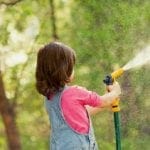Newsletter Articles
Spring is Here and This is What You Need To Do
Written by Susan B.
We’re all eager to see winter end so we can get on with the preparations and planting so we can enjoy the fruits of our labors later this spring and throughout the growing season. Even if you think you know what you have to do to go about preparing for spring, we’re going to spell everything out in detail. You can think of this blog post as a handy checklist to help you make sure that you haven’t left any stones unturned.
Sterilize Your Garden Tools
You probably cleaned your garden tools before you put them away at the end of the growing season last year. But you may not have taken the time to sterilize them. And sterilization is the only way to ensure that you won’t pass invisible bacteria or fungal spores on through the soil or when you do your routine garden chores.
Gather your tools and fill a gigantic tub, bucket, or trash can with a solution of 10% bleach to 90% warm water. Leave your tools and supplies in the liquid for at least an hour. Alternatively, you can use any disinfectant cleaner at the same ratio as the bleach and water. Rinse the tools and dry them thoroughly to prevent rusting. Apply a thin coat of oil on your tools to prevent rusting. You can extend the life of your tools if you do this after cleaning them every time you use your garden tools.
Sharpen Your Tools and Lawn Mower Blade
Your loppers, pruners, spades, hoe, and shovel get dull over time. So will your lawnmower blade. Before you head out to tackle a job where you need to use these tools, make sure that their blades are sharp. By preparing your tools before you need to use them, you’ll optimize the efficiency when doing garden chores, and you’ll save time in the process.
Get Your Garden Beds Ready
Despite your painstaking efforts to keep weeds at bay, they seem to appear out of nowhere magically. And unless you remove them at their roots, they’ll just grow back with more vigor. Use a hand weeder to loosen roots. It may take longer to remove them by hand, but you’ll be able to prevent hidden seeds from falling in the dirt. Use a shovel to loosen any compacted soil. It will also help you see any evidence of pests who burrow deep below the surface of the ground so you can dislodge them.
Conduct a Soil Test
Take a soil test before you add amendments to your beds. You can test the soil pH at the same time. Many local retailers sell soil testing kits. If you can’t find one, place a sample in a clean container and take it to your local county extension office. If you loosened compacted soil during your clean up, think about adding Perlite, coconut coir, or any organic product that enhances soil airflow.
Prepare Raised Beds
If you have raised beds that you plan to use to grow vegetables or fruit crops, now is the time to get them ready. Remove any weeds, dead plant growth that you may have missed when you cleaned things up at the end of last season, turn cover crops over, if you planted them, and add topsoil, compost, and other amendments to the bed, so you don’t have to do these things before you plant.
Prune Shrubs and Prune and Divide Perennials
The ideal time to prune shrubs is as soon as you see the first spring leaves emerge. Pruning them now instead of at the end of the growing season helps you distinguish between dead branches and live growth.
If you didn’t trim your perennials to about two inches above the ground late last fall, now is the time to do this. And if you’ve had your perennials in the ground for several years, now is the time to divide them. You’ll need to dig up the root ball. A Japanese Hori Hori knife is the best tool to use for garden chores like this. You’ll be able to use it to loosen the root ball, and the sharp knife edge will cut through the roots to allow you to divide your plants. Replant a couple of divisions in the same place, and find another spot in your garden for the remainder.
Prepare Containers for Potted Plants
Pots filled with colorful annuals are a delightful way to introduce early Spring color into your landscape. You can also use them on your patio, deck, porch, or even place them in your garden beds. But before you fill them with your favorite flowering annuals, be sure they are empty, clean, and sterile. You can soak pots in a solution of 10% bleach to 90% water to sterilize them.
 Inspect Garden Hoses and Irrigation Sprinklers
Inspect Garden Hoses and Irrigation Sprinklers
Before your garden is up and growing, be sure to inspect garden hoses for puncture holes, or defective hose fittings or faucet connectors. You don’t want to run into problems during the height of the growing season. If you have an irrigation system, check the sprinklers, hoses, and computer settings to make sure that everything is working correctly.
Now that you’ve finished your pre-season garden chores, we encourage you to come into one of our stores to check out our vast selection of colorful annuals and perennials, and the variety of seeds we stock. Our garden experts are always eager to help customers choose plants and flowers that are most suited to their personal and landscape needs.
Do you like what you see? Sign up for our weekly newsletter to get content like this every week!

